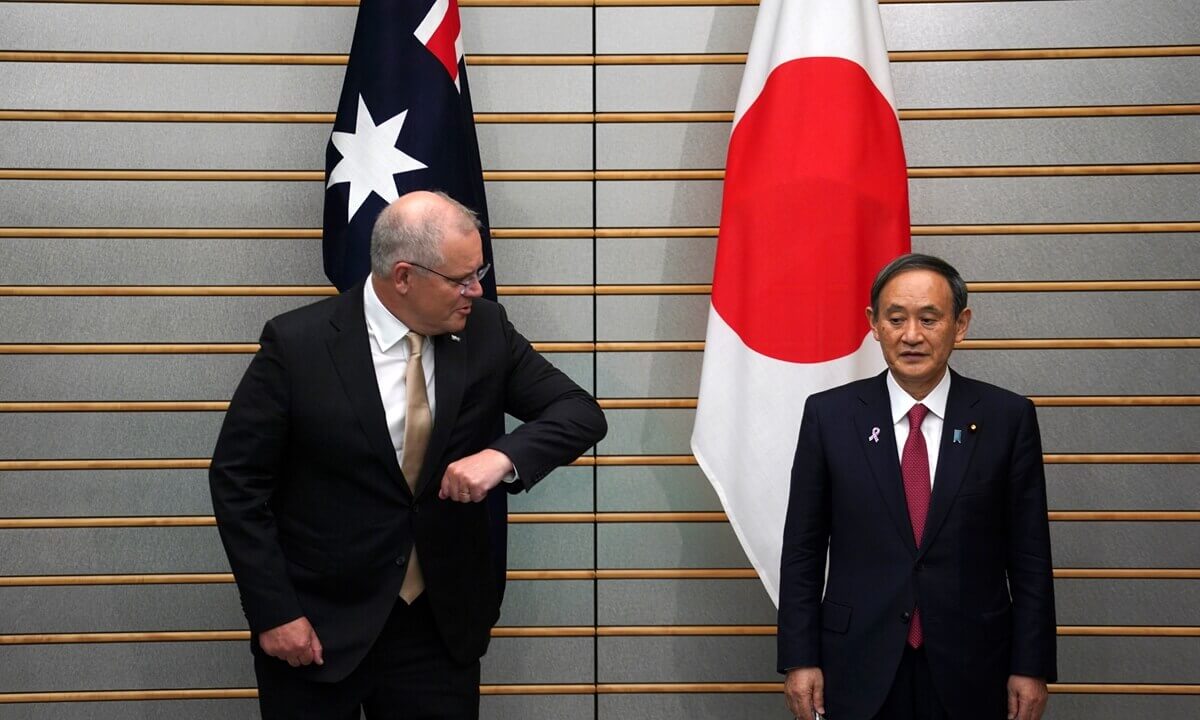Following Australian Prime Minister Scott Morrison’s visit to Tokyo, the Japanese and Australian leadership announced on Tuesday that they have reached agreement on a historic defence pact. The Reciprocal Access Agreement (RAA) signed between the two countries is a broad agreement that provides legal status to troops of both nations to travel to each other’s countries, conduct joint military exercises and training, and cooperate on humanitarian disaster relief.
The RAA is Japan’s first agreement of its kind after the one that Tokyo signed with Washington back in 1960, which allowed the U.S. to further its national security interests in the region by basing its warships, jets and troops on Japanese soil, while also extending security to Tokyo. Australia and Japan have been negotiating a defence deal for six years, but the need to expedite talks has been driven by China’s rising aggression rises in the Indo-Pacific region at large. However, the agreement still needs to be ratified by the legislatures of both nations.
Addressing a joint news conference, Japanese Prime Minister Yoshihide Suga said, “I hereby announce that we reached agreement in principle on a reciprocal access agreement, which had been negotiated to elevate security and defence cooperation between Japan and Australia to a new level.” His Australian counterpart Morrison added that the pact “establishes streamlined arrangements to support the deployment of defence forces more quickly and with less administration”.
The RAA between the two American allies comes as a time when China’s territorial claims and aggression in the South China Sea (SCS) and the East China Sea (ECS) have been dramatically increasing. For instance, China claims the Senkaku islands as it own, calling them the Diaoyus. While the islands have been administered by Japan since 1972, China asserts that the islands are an “inherent part” of Chinese territory, saying that its claims to the isles date back hundreds of years. Over the past few months, China has deployed ships to waters near the islands on multiple occasions. Indeed, China claims nearly all of the SCS’ 1.3 million square miles as its own.
Australia, on the other hand, has been invited to take part in the Malabar naval exercises with the US, Japan, and India, elevated its relationship with India from a Strategic Partnership to a Comprehensive Strategic Partnership (CSP), and joined US warships in pressuring Chinese vessels to withdraw from Malaysia's exclusive economic zone (EEZ). Therefore, Australia, too, is increasingly aware and wary of Chinese assertiveness and has sought to bolster bilateral and multilateral engagements.
Accordingly, the joint statement released by Suga and Morrison said that the two allies have agreed on the necessity for a framework to allow the Japanese military to protect Australian forces if needed. Without naming a country, the leaders expressed their concerns about “recent negative developments and serious incidents in the South China Sea, including the militarization of disputed features, dangerous coercive use of coast guard vessels”.
Among other issues, the leaders also discussed their apprehension about the ECS, and the imposition of the restrictive national security law in Hong Kong by China. Furthermore, the two nations also agreed to increase cooperation in 5G networks technology, undersea cables and resource security in the supply of critical minerals.
Like Japan, Australia’s relations with China have also been on the decline in the recent past. It became the first country outside the South China Sea region to voice its opposition against China’s territorial claims and construction of artificial islands in the area with the United Nations. The South China Sea region is estimated to account for roughly a third of all global shipping, and is rich in oil and gas, and is a hotbed for commercial fishing. At the same time, Australia’s actions are also indicative of it aligning its foreign policy outlook with that of the U.S.
Coincidentally, on the same day, China began its own military training exercises in the South China Sea, which are scheduled to run until the end of November. Furthermore, in response to the agreement between Australia and Japan, Beijing’s Foreign Ministry spokesperson, Zhao Lijian, said on Wednesday that “It is clear that some people in Australia, with their Cold War mentality and ideological prejudice, tend to regard China’s development as a threat and have subsequently taken a series of wrong moves related to China”.
Additionally, Chinese state-owned news outlet Global Times said that this “reckless” move by the two nations was not just “unfair” and “dangerous”, but was also forcing China to “to take some sort of countermeasures” by forming military alliances of its own with other nations. “We suggest Japan and Australia exercise restraint on the way to form a quasi-military alliance against China,” it wrote later on Tuesday. “They will surely pay a corresponding price if China’s national interests are infringed upon and its security is threatened,” it further added.
Japan Agrees Military Pact with Australia With One Eye on China
Australia and Japan have agreed on a defence pact that will allow their forces to train in each other’s territory. Both Tokyo and Canberra are navigating tensions with an increasingly assertive China.
November 18, 2020

SOURCE: AFP
